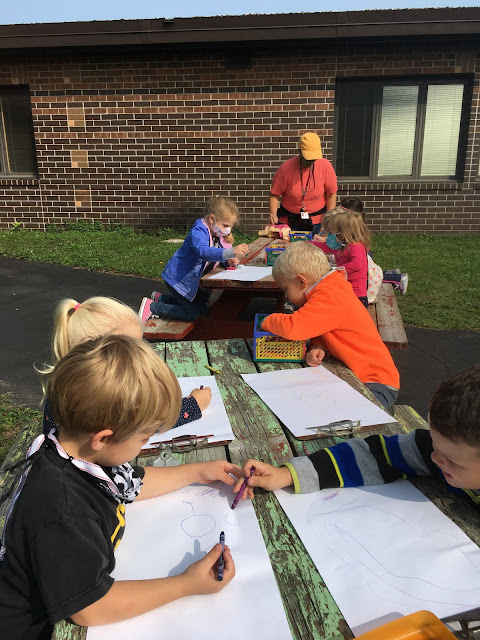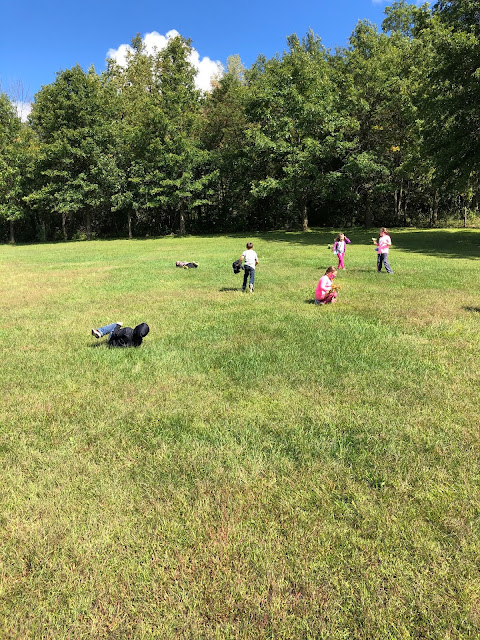Guest post by Barb Duerksen, KVR Instructor
It’s fall and birds are on the move. Cold weather means fewer insects, so the
birds that depend entirely on insects for staying alive must migrate–they fly
south to find enough to eat.
October and November are exciting months for people who enjoy
seeing birds that are flying in from farther north. Some are species that we can find only during
the time of migration.
The Ruby-crowned Kinglet is a migrant that I’ve seen along
the roadsides recently. They are
olive-colored with white wing bars and a white eye ring. They are small and energetic, flying quickly
through the shrubs, weeds, and trees, searching for food and flicking their
wings almost constantly. In fall the
kinglets are quiet, except for a soft two-noted “jidit” call. The ruby-colored spot on top of the male’s
head is usually hidden in fall. When
they come back through in the spring, the males display that bright red spot,
and sing a sweet warbly song. (Listen to
the song and call here by clicking on the Audio button.)
Most Kinglets will be gone by the end of October. They will spend the winter in the southern
United States and Mexico.
Waterbirds are another group of birds that migrate. They live on or near water, so when it gets cold enough for the water to freeze, they fly south to warmer places. Late October through November is a good time to find geese, swans, and many different species of ducks on ponds and rivers. Tundra Swans are huge white birds with long necks that nest in the far north Arctic tundra. When the weather turns cold, many of them fly south and east, some stopping at resting places like the Mississippi River for a time while they tank up for the rest of the flight. Many spend the winter in the Chesapeake Bay area on the east coast. Goose Island and south along the Mississippi River are good places to find hundreds of these swans in November and sometimes into early December, depending on when freezing temperatures arrive. They call constantly during migration, a high musical “hoo hoo” sound. When you hear that, look up, and you’ll see a flock of big white birds heading south east. Sometimes they migrate at night. (Listen to their call here by pressing the Audio button.)
The birds that can stay alive eating seeds don’t need to
leave when the insects disappear. They
can usually find food all winter. These birds stay here year-round and are appropriately called
resident birds. Black-capped Chickadees, White-breasted Nuthatches, cardinals,
Blue Jays, goldfinches, some sparrows, and many of the woodpeckers are
residents who stay here through the winter. Some birds like Dark-eyed Juncos and Purple Finches fly here from the
north and stay for the winter. Putting up
a bird feeder in the yard is a good way to enjoy the familiar birds and learn
about the new species that arrive for the winter. Birds do have a harder time finding food when
there is lots of snow on the ground and it gets very cold. It is important when
there is nasty weather to keep the feeders full.
Here are some things to consider when you set out to feed birds:
Placement: Keep the feeder within 3 feet or farther than 30 feet from your window to avoid birds crashing into the window.
Cover: Put the feeder near some cover, so the smaller birds have a place to hide when predators come along. If you put a post in the ground near the feeder now before the ground freezes, you can tie your used Christmas tree to the post
Sanitation: Keep your feeders clean so birds don’t get diseases.
Safety/Predators: If you live where there are lots of outdoor cats, it’s really not a good idea to put up a feeder.
For more information about feeding birds: Visit Cornell Laboratory of Ornithology’s All About Birds site.
What to feed the birds? A simple way to start is to put out black oil sunflower seeds and a suet feeder. Most of the birds we have here in the winter like the sunflower seeds. Woodpeckers especially like suet. You can buy suet blocks at the feed stores, or raw suet from a meat locker. You should only use the raw suet when the weather is cold, as it can get messy and turn rancid in warn weather.
Here are some birding activity ideas to inspire you to get out as we move through the fall season.
- Spend a little time outdoors on a walk or sitting still. Listen for bird calls. If you hear chickadees, look nearby for other species. Sometimes migrant birds follow the chickadees on their feeding routes.
- After the leaves are gone and before there’s snow on the ground, the world can seem drab and gloomy. Maybe it’s time to celebrate drab. Bundle up, go out, find 10 things that you would consider drab, and take another look.
- Spend some time learning about Audubon's 121st Christmas Bird Count that will be conducted between the dates of Monday, December 14, 2020 through Tuesday, January 5, 2021. This is a great way to get involved in citizen science.










